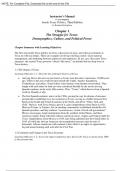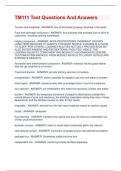NOTE: For Complete File, Download link at the end of this File
Instructor’s Manual
to accompany
Inside Texas Politics, Third Edition
by Brandon Rottinghaus
Chapter 1
The Struggle for Texas:
Demographics, Culture, and Political Power
Chapter Summary with Learning Objectives
The first step inside Texas politics involves a discussion of taxes, and what governments in
Texas do with tax dollars. There are examples involving wild hog control, waste material
management, and mediating between employers and employees. In any case, like many Texas
taxpayers, the current Texas governor “doesn’t like taxes,” an attitude that has deep roots in
Texas history.
1.1 The Origins of Texas
Learning Objective 1.1: Describe the settlement history of Texas.
• Arriving first to the area we now know as Texas were the native Americans, 10,000 years
ago. Tribes in the area would in time include the Caddo, Apache, Karankawa,
Coahuiltecan, and others. Some fished, some farmed, some hunted on horseback. They
fought with each other for land yet were considered friendly by the newly arriving
Spanish explorers in the early 16th century. Thus, “Texas,” which derives from a Spanish
word for friendly or ally.
• The first Spanish explorers arrive in the 1500s, paving the way for dozens of missions
and presidios established over two centuries in Texas, serving as a buffer between New
Spain in the South and French Louisiana in the North, and all for “Glory, God, and
Gold.” Mexico, with Texas being a part of it, gains independence from Spain in 1821.
Mexican Texans, or Tejanos, live in ranching communities established around the old
Spanish presidios, and they embrace “ayuntamiento, a form of local self-government.”
Mexico encourages Anglo immigration from the southern United States, and these
American Anglos bring with them African American slaves. Anglos and Tejanos fight for
Texas’ independence from Mexico in 1836, later being admitted into the United States in
1845, all while the African American slave population increases into the tens of
thousands. African Americans will continue to have little to no rights or opportunities
beyond tenant farming until well after the Civil War.
1.2 Continuity and Change in the Texas Economy
Learning Objective 1.2: Assess the impact industries have had on the Texas economy from 1860
to the present time.
© Oxford University Press
, • The Texas economy was agricultural (cotton and then cattle) through the 19th century,
then relied heavily on oil and gas in the 20th century, and since some booms and busts in
the oil markets, Texas has successfully developed the kind of diversified set of industries
we see today across the state. Today, the Texas economy is the second largest in the
United States, ranking 10th in the world, and in addition to energy relies on such things
as technology, manufacturing, real estate, and military/defense contracting.
• The energy markets still strongly effect the health of the Texas economy. Texas, for
example, enjoyed an oil boom in 2001-2008, coinciding with strong growth in many
other sectors, adding up to enough economic success to be dubbed “the Texas Miracle.”
Texas’ big cities enjoyed much of this growth, and there we find that many of the new
jobs were unfortunately low-pay positions, and economic inequality rose between rich
and poor and between white and non-white. The state has recently been struggling with
the COVID-19 pandemic, seeing historically high unemployment and dwindling tax
revenues.
1.3 Continuity and Change in Texas Demographics
Learning Objective 1.3: Analyze how the changing demographics of the state affect government.
• Texas’ population is growing fast, with its native birth rate helped by both newly arriving
immigrants and existing Americans relocating to Texas due to its economic expansion
and affordable real estate. Due to both native Hispanic birth rates and immigration, Texas
is also becoming more Hispanic. It is also becoming more suburban, in part because some
Texans, especially whites, are relocating from more congested and expensive urban
dwellings out to the ‘burbs. Rural communities featuring smaller family farms are
declining.
• Texas’ changing population features three areas of concern: how to publicly
accommodate a growing population, how to harmonize and integrate a diversifying
population, and how to care for an aging population. More people mean greater demand
on government to ensure the availability of more traffic lanes, water, electricity, and
health care (Hispanics have particularly low rates of being insured). Residential racial
segregation is common in Texas, which corresponds with socially and politically
challenging inequalities between communities of predominantly one racial or ethnic
group across Texas regarding education, income, and housing. The elderly in Texas also
need government attention, as they are especially vulnerable to illness and crime, and are
disproportionately poor.
1.4 Continuity and Change in Texas Political Culture
Learning Objective 1.4: Examine the source and impact of political culture in Texas.
• Texas has a distinctive identity that has been forged out of its historical experience, and
we can characterize that identity in terms of political culture, or how citizens view their
political relationship to the government and what their ideals and expectations of it are.
• Political scientist Daniel Elazar argues that there are three types of political culture:
Individualistic, Traditionalistic, and Moralistic. He categorizes Texas as part
Individualistic and part Traditionalistic. An Individualistic political culture values
© Oxford University Press
, individual accomplishment and limited government. It distrusts the government, viewing
it as a necessary evil to resolving limited disputes, and instead putting its trust in the free
market. On the other hand, the key features of a Traditionalistic political culture are
political hierarchy, law and order, and religiosity. Friction between these two cultures can
arise: The Traditionalistic culture prefers policies such as regulating abortion, prohibition
of drugs, and raising revenue via sin taxes, whereas the Individualistic culture tends to
oppose these things.
Lecture Suggestions
1. What could be the next possible economic trend for Texas?
[LO 1.2]
2. Of the challenges of an aging population facing Texas, which do you think is the most
serious? Why? Are there any possible solutions that you can think of?
[LO 1.3]
3. Of the challenges of a growing population facing Texas, which do you think is the most
serious? Why? Are there any possible solutions that you can think of?
[LO 1.3]
4. Texas is a land of immigrants. How have immigrants affected the state in the past and how do
you think they are currently affecting the state?
[LO 1.3]
5. What political culture do you think best reflects the community you live in? Why?
[LO 1.4]
Classroom Activities
1. Divide the students into groups of three. Refer them to the section of chapter one title
“Challenges of Population Growth.” Have them, as a group, rank the challenges. Which do they
believe will be the biggest problems for the state going forward, and why?
[LO 1.3]
[Use Student Handout #1]
2. Divide the students into groups and direct them to Table 1.1. Where would they place the
community that they live in the categories listed? According to the text, what is that supposed to
mean for the make-up and political influence of their community? Does that fit with the reality
that they see? Are there differences between the home communities of group members that they
can compare and contrast?
[LO 1.3]
[Use Student Handout #2]
© Oxford University Press





